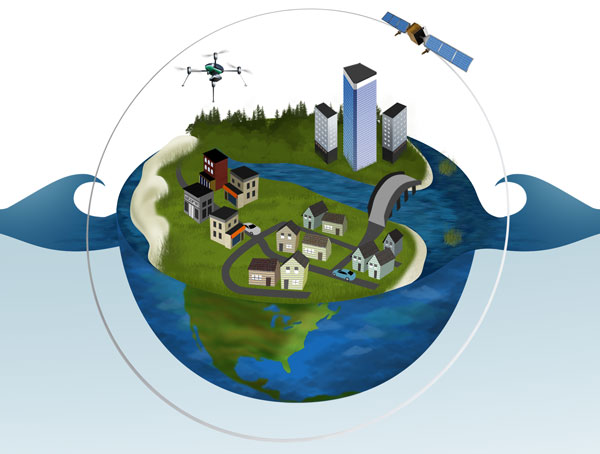About
The Project
Living near the coast, communities have been aware of how the coast provides resources (storm protection, clean water, economical products, etc.) and beautiful places to enjoy. However, communities are also aware of the dangers that arise from being near the coast, hurricanes and storm surges to name a few. The collaborative research team is composed of multidisciplinary departments within Rowan University; Civil and Environmental Engineering, Transportation Engineering, Structural Engineering, Sociology and Anthropology, and Geography.

Rowan University Engineering Departments has significant national and international expertise with respect to civil and environmental engineering, including transportation management, disaster, climate change, and resiliency.
With Rowan University’s new tool, NJFloodAlert, coastal communities and decision makers in New Jersey will have the resources to explore the most up to date and highest resolution flood models. Current tools offer regional scale flood models whereas NJFloodAlert will offer regional and localized results. Users will be able to view different flooding scenarios produced by historical data of various category hurricanes. It will also provide vulnerability analysis of critical infrastructures and road networks. Once a community or individual has established vulnerabilities, different engineering and green mitigation solutions will show the users how each option could improve their vulnerability.
Some coastal New Jersey towns have already started to become more resilient in the face of increased coastal storms. Rowan University is excited to help communities take the next step in planning for future resiliency.
Goals
Rowan University has created a groundbreaking high resolution flood model for two towns in Middlesex and Ocean Counties in New Jersey, with many more towns in progress. With this never been done before high resolution modelling, Rowan is actively trying to inform and protect communities from flooding and storm surges. NJFloodAlert will let communities explore different flooding scenarios and mitigation options.
This interactive mapping website was created to provide a user-friendly visualization tool to help local communities and government agencies to make informed decisions concerning flooding conditions, hazards, sensitive and critical zones and infrastructure and mitigation options. This website could be used to promote enhanced preparedness and storm related planning decisions.
Support
This project was funded by The New Jersey Department of Community Affairs.
The Department of Community Affairs (DCA) manages the majority of the federal funds being used to assist the State in recovering from Superstorm Sandy. These funds come from the Community Development Block Grant (CDBG) Disaster Recovery programs of the U.S. Department of Housing and Urban Development.
While many of the DCA Sandy Recovery programs are designed to help homeowners, tenants, landlords and developers, DCA has also establish several programs designed to assist local governments. One such program, the Statewide and Regional Planning Assistance Grant Program (SRPAG) is funding three universities to augment the local government planning initiatives undertaken as a result of Superstorm Sandy. The university grants were made to support the application of research to local pre-disaster planning and recovery activities.
Administered by the DCA Office of Local Planning Services (LPS), the program is funding mitigation planning and recovery-related activities that have the potential to benefit defined regions and/or the entire state. SRPAG-funded projects are addressing a range of storm-related resiliency issues including social, economic, environmental, and/or infrastructure needs. The funded activities also promote community engagement and collaboration at a regional level to further strengthen resilience via final work products that will be replicable beyond the initial phase of several pilot projects.
The Team
This is a collaboration between Rowan University, NJ Department of Community Affairs, and local decision makers in New Jersey.
The collaborative research team at Rowan University is composed of multidisciplinary departments; Civil and Environmental Engineering, Transportation Engineering, Structural Engineering, Sociology and Anthropology, and Geography. Rowan University Engineering Departments has significant national and international expertise with respect to civil and environmental engineering, including transportation management, disaster, climate change, and resiliency.
- Dr. Rouzbeh Nazari • Principal Investigator & Project Leader
- Dr. Dot Lundberg • Post Doctorate Researcher & Project Coordinator
- Dr. Parth Bhavsar • Co-Principal Investigator
- Dr. Amir Iranmanesh • Co-Principal Investigator
- Dr. DeMond Miller • Co-Principal Investigator
- Dr. Zach Christman • Co-Principal Investigator
- Dr. Hosein Motamedi • Post Doctorate Researcher
- Fahad Rabbani • Graduate Research Assistant
- Plaban Das • Graduate Research Assistant
